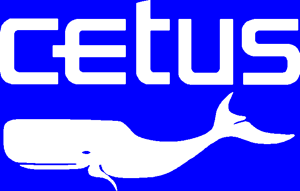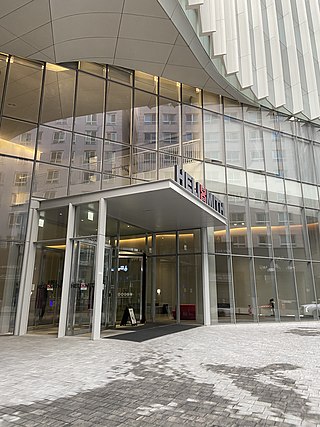
Cytokines are a broad and loose category of small proteins important in cell signaling. Due to their size, cytokines cannot cross the lipid bilayer of cells to enter the cytoplasm and therefore typically exert their functions by interacting with specific cytokine receptors on the target cell surface. Cytokines have been shown to be involved in autocrine, paracrine and endocrine signaling as immunomodulating agents.

Biogen Inc. is an American multinational biotechnology company based in Cambridge, Massachusetts, United States specializing in the discovery, development, and delivery of therapies for the treatment of neurological diseases to patients worldwide. Biogen operates in Argentina, Brazil, Canada, China, France, Germany, Hungary, India, Italy, Japan, Mexico, Netherlands, Poland, Sweden, and Switzerland.

Interferon beta-1a is a cytokine in the interferon family used to treat multiple sclerosis (MS). It is produced by mammalian cells, while interferon beta-1b is produced in modified E. coli. Some research indicates that interferon injections may result in an 18–38% reduction in the rate of MS relapses.

Biolex Therapeutics was a biotechnology firm in the Research Triangle of North Carolina which was founded in 1997 and raised $190 million from investors. It filed for Chapter 7 bankruptcy on July 5, 2012.
Interferon beta-1b is a cytokine in the interferon family used to treat the relapsing-remitting and secondary-progressive forms of multiple sclerosis (MS). It is approved for use after the first MS event. Closely related is interferon beta 1a, also indicated for MS, with a very similar drug profile.

Alemtuzumab, sold under the brand names Campath and Lemtrada among others, is a medication used to treat chronic lymphocytic leukemia and multiple sclerosis. In chronic lymphocytic leukemia, it has been used as both a first line and second line treatment. It is given by injection into a vein.

Cetus Corporation was one of the first biotechnology companies. It was established in Berkeley, California, in 1971, but conducted most of its operations in nearby Emeryville. Before merging with Chiron Corporation in 1991, it developed several significant pharmaceutical drugs as well as a revolutionary DNA amplification technique.

Bruton's tyrosine kinase, also known as tyrosine-protein kinase BTK, is a tyrosine kinase that is encoded by the BTK gene in humans. BTK plays a crucial role in B cell development.
Multiple sclerosis (MS) is a chronic inflammatory demyelinating disease that affects the central nervous system (CNS). Several therapies for it exist, although there is no known cure.
Ocrelizumab, sold under the brand name Ocrevus, is a medication used for the treatment of multiple sclerosis (MS). It is a humanized anti-CD20 monoclonal antibody. It targets CD20 marker on B lymphocytes and is an immunosuppressive drug. Ocrelizumab binds to an epitope that overlaps with the epitope to which rituximab binds.

The type-I interferons (IFN) are cytokines which play essential roles in inflammation, immunoregulation, tumor cells recognition, and T-cell responses. In the human genome, a cluster of thirteen functional IFN genes is located at the 9p21.3 cytoband over approximately 400 kb including coding genes for IFNα, IFNω (IFNW1), IFNɛ (IFNE), IFNк (IFNK) and IFNβ (IFNB1), plus 11 IFN pseudogenes.
Research in multiple sclerosis may find new pathways to interact with the disease, improve function, curtail attacks, or limit the progression of the underlying disease. Many treatments already in clinical trials involve drugs that are used in other diseases or medications that have not been designed specifically for multiple sclerosis. There are also trials involving the combination of drugs that are already in use for multiple sclerosis. Finally, there are also many basic investigations that try to understand better the disease and in the future may help to find new treatments.

Interferon alpha-1 is a protein that in humans is encoded by the IFNA1 gene.

Sidney Pestka was an American biochemist and geneticist. A recipient of the National Medal of Technology, he is sometimes referred to as the "father of interferon" for his groundbreaking work developing the interferons as treatments for major diseases such as hepatitis, multiple sclerosis, and cancer. Pestka was part of the team working on research involving the genetic code, protein synthesis and ribosome function that led to the 1968 Nobel Prize in Physiology or Medicine received by Marshall Warren Nirenberg.

Antibody–drug conjugates or ADCs are a class of biopharmaceutical drugs designed as a targeted therapy for treating cancer. Unlike chemotherapy, ADCs are intended to target and kill tumor cells while sparing healthy cells. As of 2019, some 56 pharmaceutical companies were developing ADCs.

Helixmith Co. LTD. is a biotechnology company located in Seoul, South Korea with US presence in San Diego. The company has an extensive gene therapy pipeline, including a non-viral plasmid DNA program for neuromuscular and ischemic disease, a CAR-T program targeting several different types of solid tumors, and an AAV vector program targeting neuromuscular diseases. Helixmith’s lead gene is Engensis (VM202), currently in phase III diabetic peripheral neuropathy (DPN) in the US. Engensis (VM202) is a plasmid DNA designed to simultaneously express two isoforms of hepatocyte growth factor (HGF), HGF 728 and HGF 723. In addition to DPN, Engensis is also being studied in diabetic foot ulcers (DFU), amyotrophic lateral sclerosis (ALS), coronary artery disease (CAD), claudication, and Charcot-Marie-Tooth disease (CMT).

Sutro Biopharma, Inc. is a public biotechnology company headquartered in South San Francisco, California focused on clinical-stage drug discovery, development and manufacturing. Using a proprietary cell-free protein synthesis platform, Sutro is working on oncology therapeutics using protein engineering and rational design. Founded in 2003 under the name Fundamental Applied Biology, the company name changed to Sutro Biopharma in 2009. William Newell, CEO as of 2024, joined Sutro in January 2009.

BCN, also known as bicyclo[6.1.0]non-4-yne, is a copper-free click chemistry probe that enables highly efficient and completely orthogonal bioconjugation to complex macromolecules including peptides, nucleic acids and proteins, including monoclonal antibodies. The most recent and powerful application of this technology has been in the field of antibody-drug conjugates which results in targeted cancer therapeutics that have an improved therapeutic index, meaning they are more effective and better tolerated. BCN is well-suited for aqueous bioconjugations due to its high reactivity with its azide counterpart and its high hydrophilicity, relative to other metal-free click chemistry probes.
There are several ways for pharmaceuticals for treating multiple sclerosis (MS) to reach the market.
James Allen Wells is a Professor of Pharmaceutical Chemistry and Cellular & Molecular Pharmacology at the University of California, San Francisco (UCSF) and a member of the National Academy of Sciences. He received his B.A. degrees in biochemistry and psychology from University of California, Berkeley in 1973 and a PhD in biochemistry from Washington State University with Ralph Yount, PhD in 1979. He completed his postdoctoral studies at Stanford University School of Medicine with George Stark in 1982. He is a pioneer in protein engineering, phage display, fragment-based lead discovery, cellular apoptosis, and the cell surface proteome.














